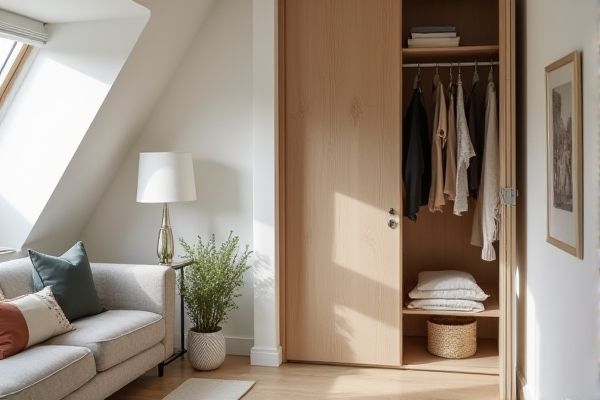
Under-stair storage maximizes often unused space by providing customized compartments ideal for smaller items or seasonal belongings, while a closet offers more traditional, spacious storage suitable for clothing and everyday use. Discover how choosing between under-stair storage and a closet can optimize Your home organization by reading the rest of this article.
Table of Comparison
| Feature | Under-Stair Storage | Closet |
|---|---|---|
| Location | Built into the space beneath stairs | Dedicated room or built-in section of a room |
| Space Utilization | Maximizes awkward under-stair space | Utilizes vertical wall space |
| Storage Capacity | Limited by stair dimensions | Typically larger and more flexible |
| Accessibility | May have limited access due to shape | Generally easy to access with standard doors |
| Customization | Custom shelves, drawers, pull-outs possible | Highly customizable with various shelving and hanging options |
| Functionality | Ideal for shoes, books, small items | Suitable for clothes, larger items, seasonal storage |
| Visual Impact | Can be discreet and space-saving | Visible part of room design |
| Cost | Generally lower due to smaller size | Can be higher depending on size and customization |
Introduction to Under-Stair Storage and Closets
Under-stair storage maximizes unused space beneath staircases, offering customizable solutions for organizing belongings in compact areas. Closets provide dedicated, enclosed storage often designed for clothing and larger items, enhancing room tidiness and accessibility. Your choice depends on spatial needs, with under-stair storage ideal for efficient use of awkward spaces versus traditional closet functionality.
Space Optimization: Under-Stair Storage vs Closet
Under-stair storage maximizes otherwise wasted space by fitting custom shelves, drawers, or cabinets into the angled area beneath stairs, ideal for compact homes or awkward layouts. Closets provide more uniform storage capacity with vertical hanging space and standardized shelving but often require a dedicated footprint, reducing usable floor area. For optimal space efficiency, under-stair storage transforms unused nooks into functional storage solutions, while closets offer traditional organization suited for larger rooms.
Accessibility and Convenience Comparison
Under-stair storage offers easy accessibility with its location directly integrated into the staircase, allowing quick access to items without entering a separate room. Closets provide more organized space but may be less convenient due to their fixed location, requiring more effort to reach frequently used items. For maximizing everyday convenience, under-stair storage is ideal for quick-grab necessities, while closets suit long-term storage needs.
Design and Aesthetic Potential
Under-stair storage offers a unique design opportunity by transforming typically unused space into customized, functional areas that blend seamlessly with home aesthetics. Unlike traditional closets, under-stair storage can be tailored with creative shelving, drawers, and concealed compartments that enhance spatial efficiency while adding visual interest. This versatility supports both minimalist and elaborate interior styles, making it a dynamic solution for modern living spaces.
Customization Options for Each Solution
Under-stair storage offers highly customizable options tailored to fit awkward angles and varying stair heights, allowing for drawers, shelves, and pull-out cabinets specifically designed to maximize limited space. Closets provide more standard forms of customization, typically including adjustable shelves, hanging rods, and built-in organizers to accommodate clothing and personal items. Both solutions can be adapted with materials, finishes, and hardware to match interior design styles, but under-stair storage excels in creating niche storage tailored to unique architectural spaces.
Cost Analysis: Under-Stair Storage vs Closet
Under-stair storage typically offers a more cost-effective solution compared to traditional closets due to its use of otherwise wasted space and reduced construction materials. Closet installation often involves higher expenses, including framing, drywall, and door costs, making it pricier especially in existing homes. Choosing under-stair storage maximizes functionality while minimizing remodeling budgets and material waste.
Installation Complexity and Time
Under-stair storage typically involves custom carpentry to fit the unique angles of the space, requiring more precise measurements and longer installation times compared to standard closets. Closets, often built with modular components, allow for quicker assembly and easier installation, saving you time and simplifying the process. Choosing under-stair storage demands patience and professional skills, while closets offer more straightforward, time-efficient solutions.
Best Uses: What to Store Where
Under-stair storage is ideal for items like shoes, seasonal decorations, and cleaning supplies due to its odd shapes and limited height, optimizing space in tight areas. Closets provide better versatility for storing clothing, linens, and larger household items with hanging rods and shelving. Your choice depends on the size and shape of the items, with under-stair spaces suited for compact, irregular items and closets designed for organized, accessible storage of bulkier belongings.
Pros and Cons Summary
Under-stair storage maximizes unused space with custom compartments ideal for smaller items, offering a discreet and cost-effective solution but limited by irregular shapes and reduced accessibility. Closets provide uniform, spacious storage with easy access and better organization options, though they require more floor space and higher installation costs. Choosing between them depends on available space, budget, and the specific storage needs of the household.
Choosing the Right Storage Solution for Your Home
Under-stair storage maximizes unused space by fitting custom drawers, shelves, or cabinets seamlessly into staircases, ideal for compact homes needing efficient organization. Closets offer more traditional, accessible storage with hanging rods, shelves, and larger capacity for clothing or bulkier items, suitable for homes with dedicated closet areas. Evaluate your home's layout and storage needs to choose the right solution that optimizes space while keeping Your belongings organized and easily accessible.
 homyna.com
homyna.com